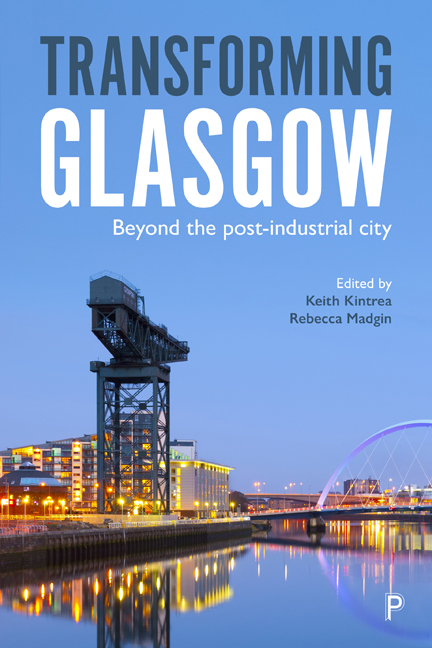Book contents
- Frontmatter
- Contents
- List of Maps, Tables, Figures and Boxes
- Notes on Contributors
- Acknowledgements
- Foreword
- Map
- Introduction: Transforming Post-Industrial Glasgow – Moving Beyond the Epic and the Toxic
- PART I
- PART II
- PART III
- Conclusion: Beyond the Post-Industrial – Narratives of Time and Place
- Index
10 - What once was Old is New Again: Placemaking and 201 Transformational Regeneration in Glasgow
Published online by Cambridge University Press: 25 March 2021
- Frontmatter
- Contents
- List of Maps, Tables, Figures and Boxes
- Notes on Contributors
- Acknowledgements
- Foreword
- Map
- Introduction: Transforming Post-Industrial Glasgow – Moving Beyond the Epic and the Toxic
- PART I
- PART II
- PART III
- Conclusion: Beyond the Post-Industrial – Narratives of Time and Place
- Index
Summary
Introduction
Glasgow's urban form is closely associated with the sandstone tenement block, a form of high-density flatted accommodation that was developed apace during the 19th century in response to exponential population growth caused by the city's rapid industrialisation. Today these characterful residences are celebrated as a resilient form of urbane accommodation, particularly in the affluent quarters of the city. For the less well off, however, tenement living was far less desirable. Until the mid-20th century, many of the city's working classes suffered in dense tenement neighbourhoods straddling polluted industrial lands where the accommodation was cramped and unsanitary. The Glasgow tenement therefore retains a certain infamy in the popular imagination of the city as providing some of the worst housing conditions in Scotland, as well as some of the most desired.
Juxtaposed against the imagery of Glasgow as a tenement city is the enduring spectre of the city's modernist reimagining as it grappled with post-industrial decline in the mid-20th century. During this era of ‘comprehensive development’ a large number of poor quality tenements were replaced by functional high-rise flats and mid-rise slab blocks. Despite laudable ambitions to improve the living conditions of the urban poor, comprehensive development proved to be physically and socially destructive as significant parts of Glasgow's urban fabric was torn apart and communities were spatially uprooted and dispersed. The result was that much of the new accommodation fell into a cycle of decline. Fragile social networks that were cleaved by the city's planners never recovered and the build quality of the new modernist towers and blocks proved, in many cases, to be substandard. By the mid-1970s, many residents were living in conditions that were not much better than those found in the condemned tenements cleared only a decade or so before.
This chapter focuses on the current phase of Glasgow's planning and design journey as the city seeks to move beyond post-industrialism and address the socio-spatial problems wrought by the comprehensive redevelopment of the inner city. Glasgow's story is contextualised within the wider turn towards design-sensitive ‘placemaking’ in UK and Scottish urban policy that began in the early 1990s and gathered speed under New Labour's ‘urban renaissance’ agenda during the 2000s (Punter, 2010).
- Type
- Chapter
- Information
- Transforming GlasgowBeyond the Post-Industrial City, pp. 201 - 220Publisher: Bristol University PressPrint publication year: 2019

